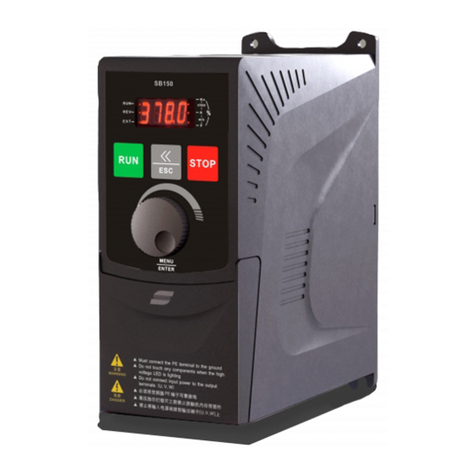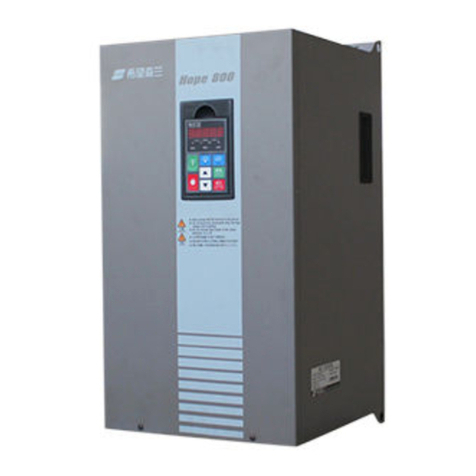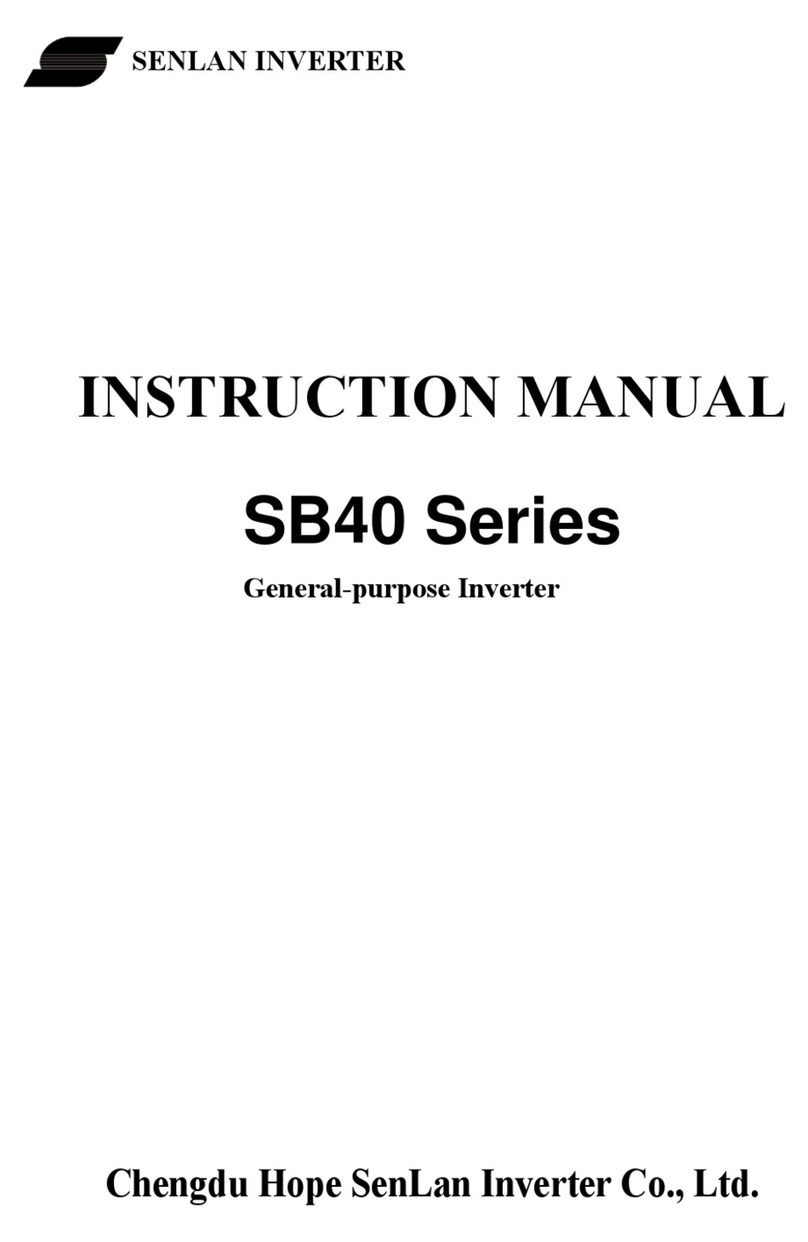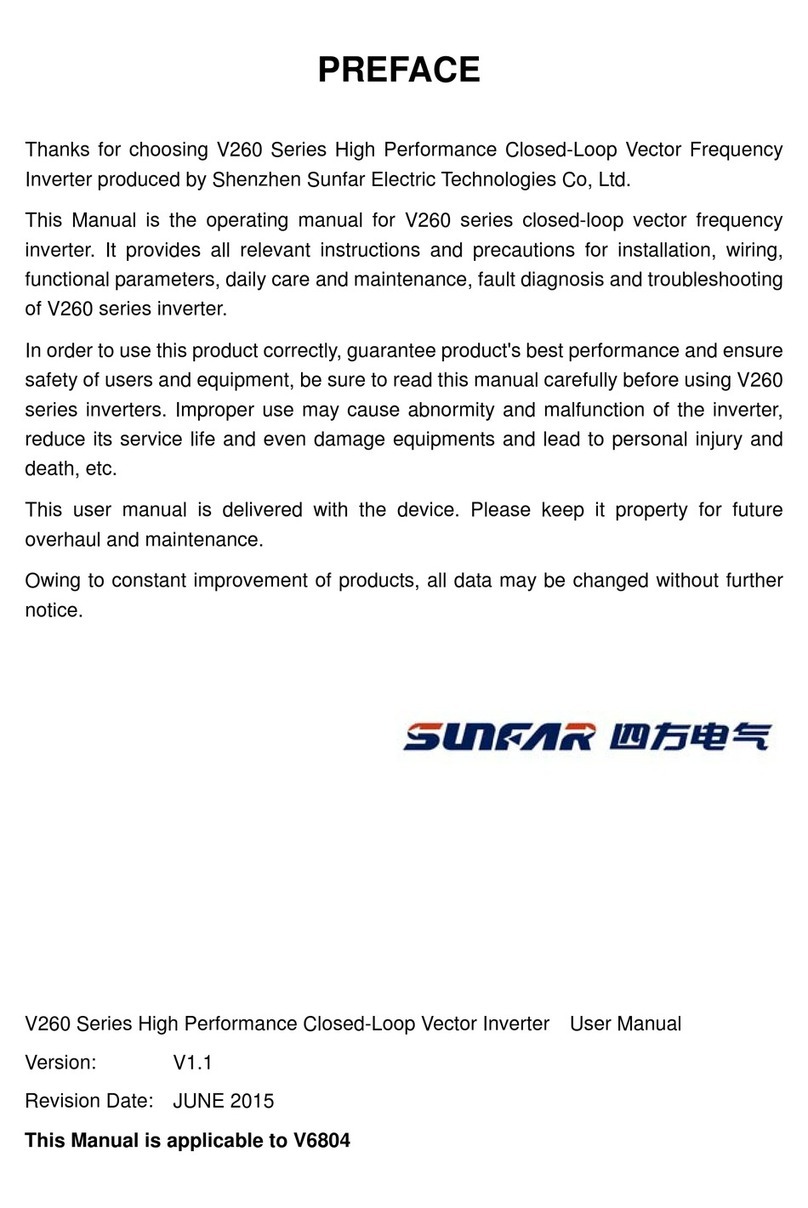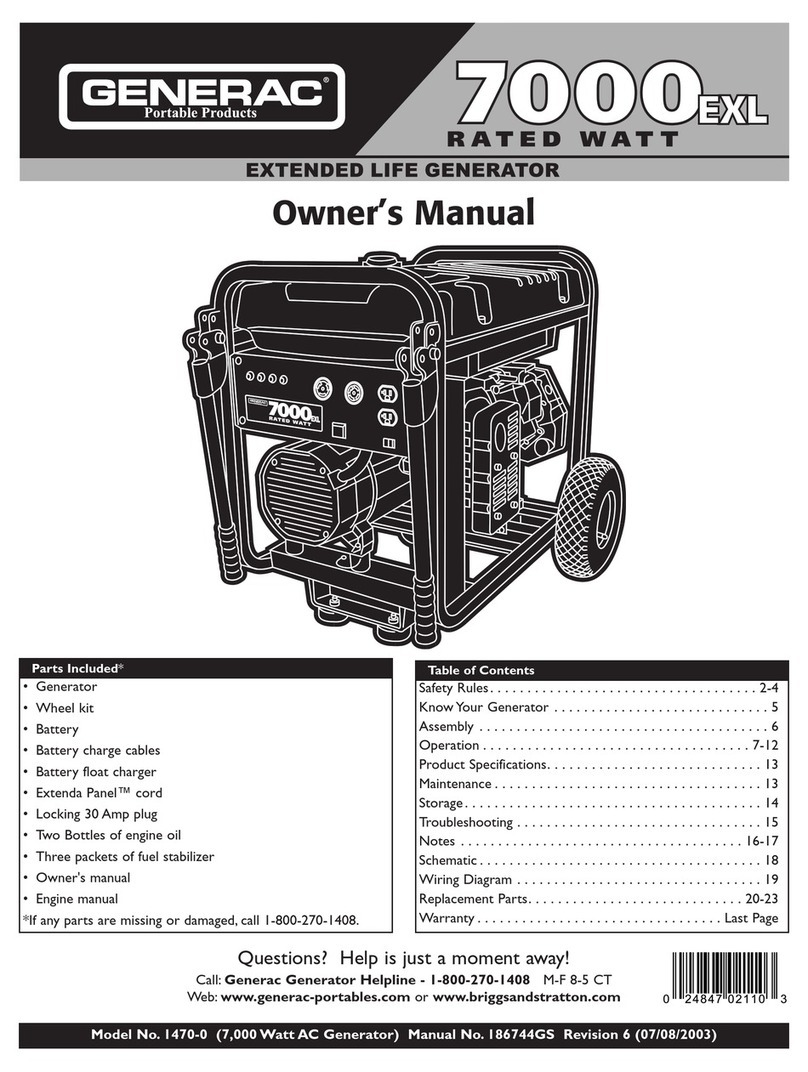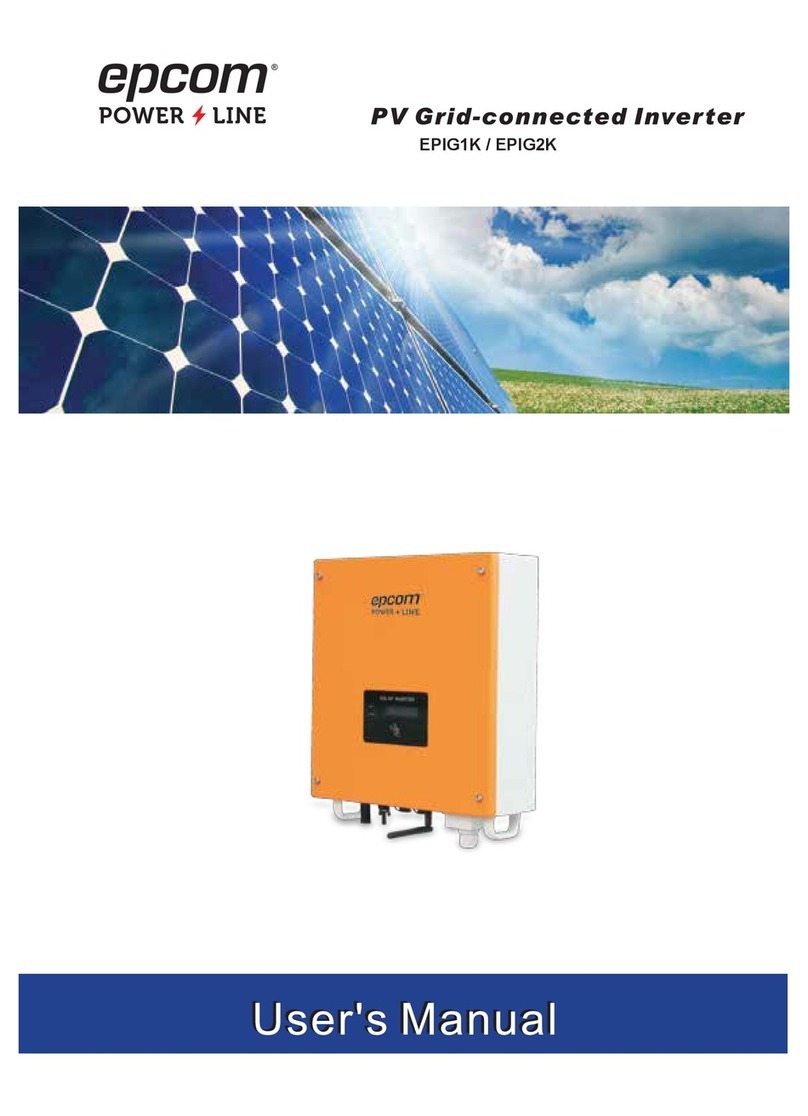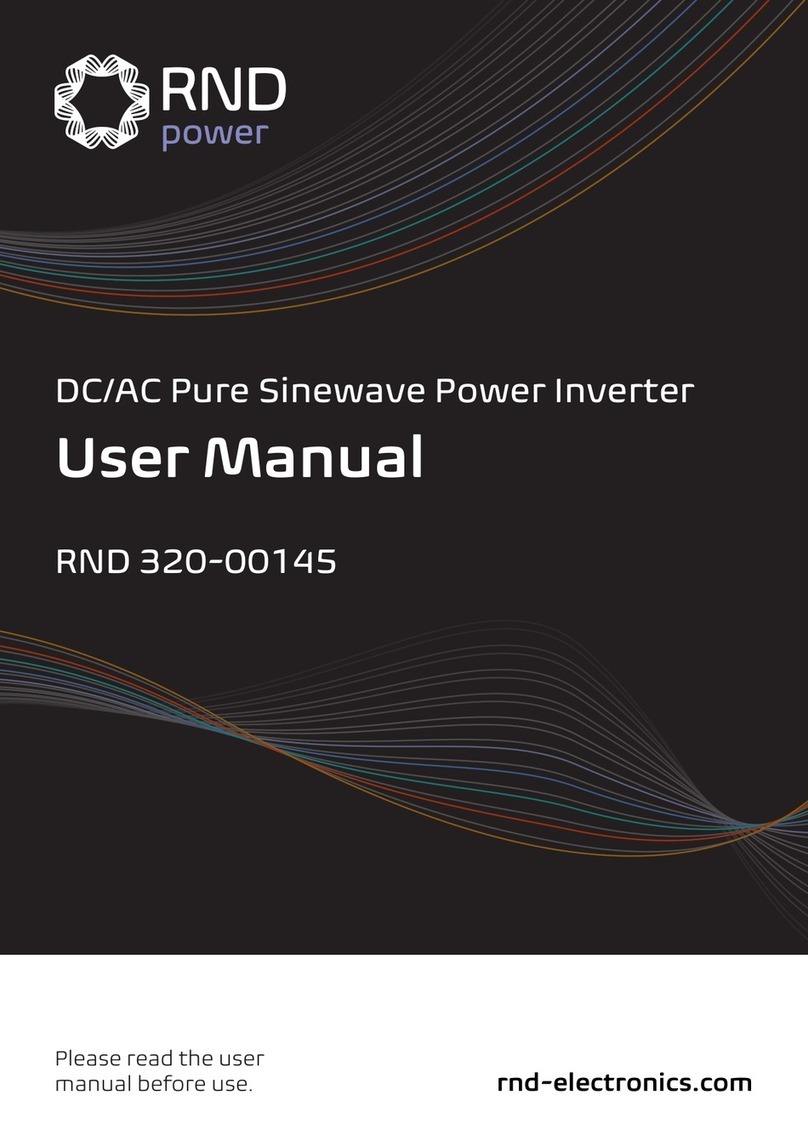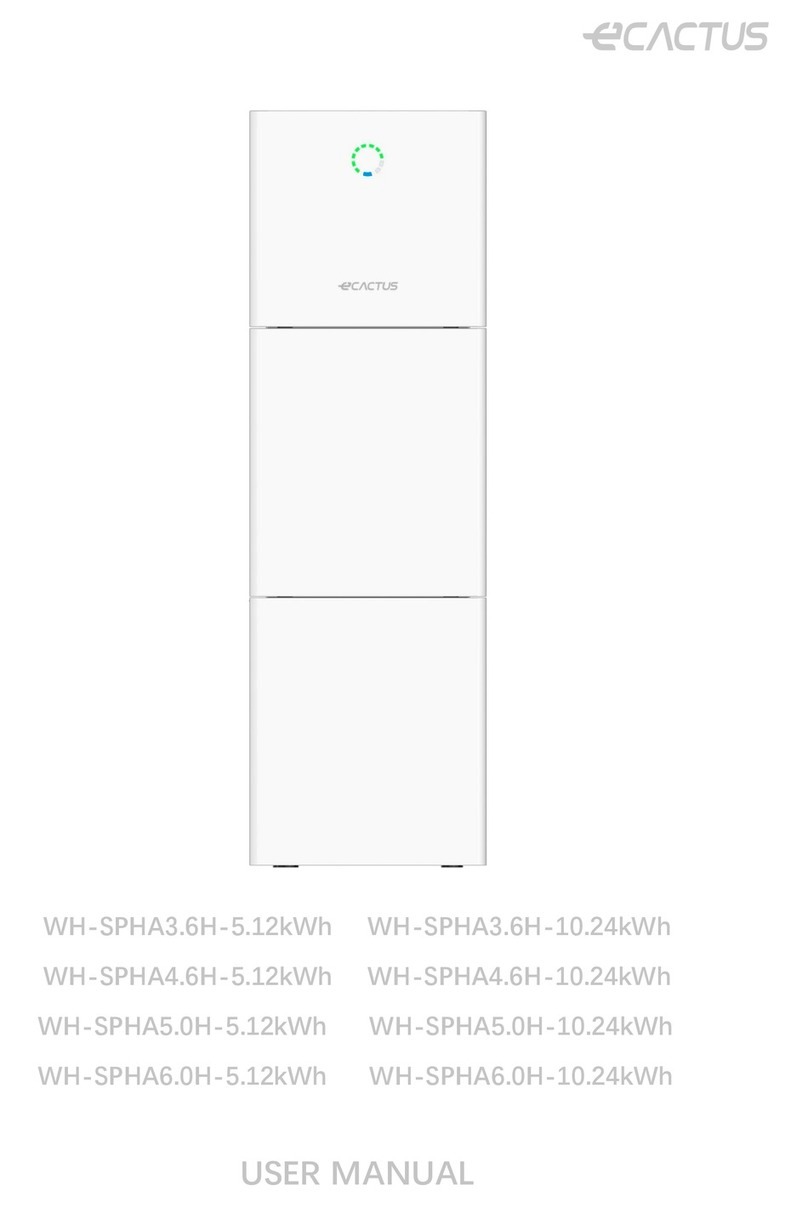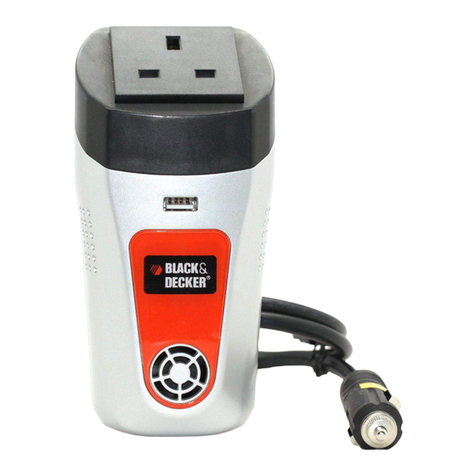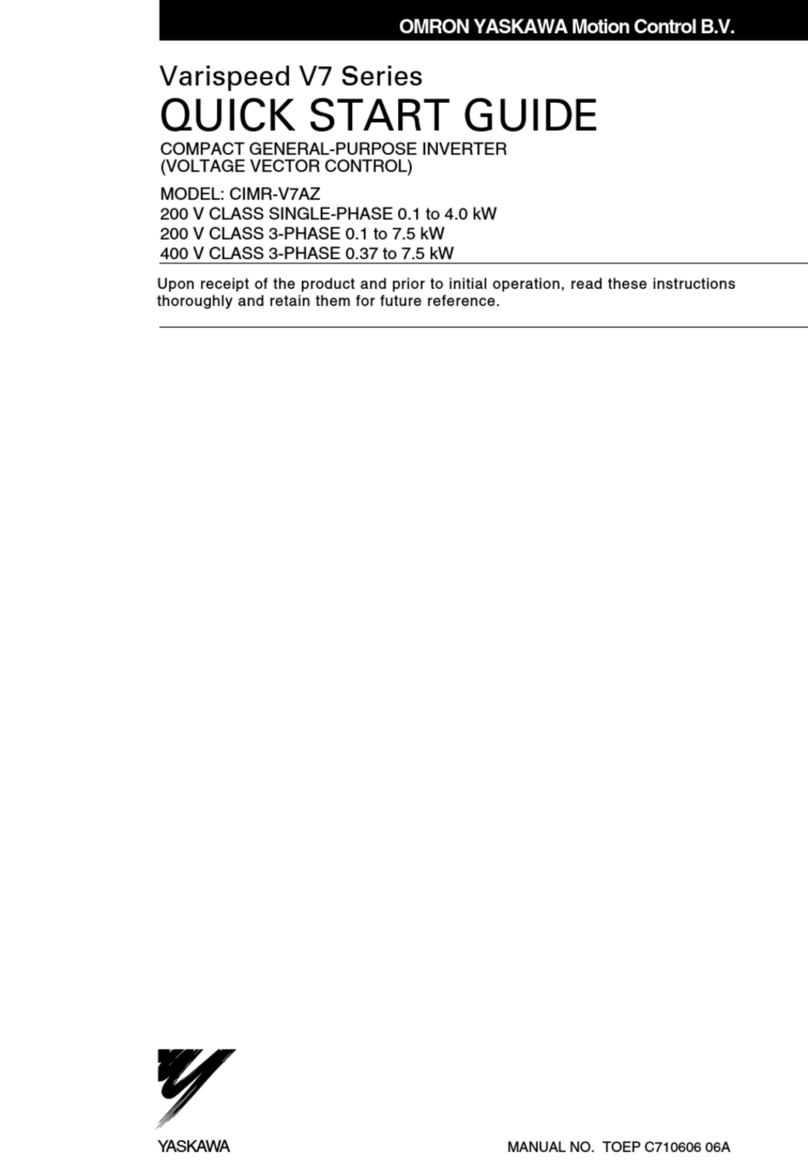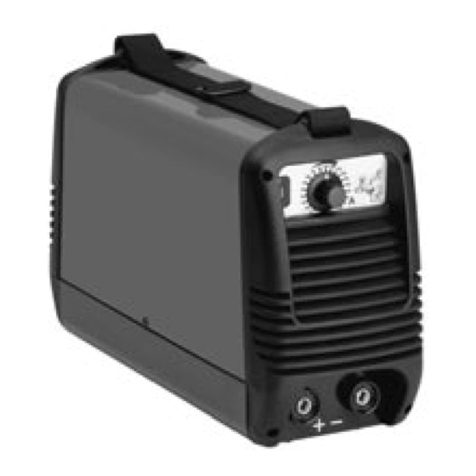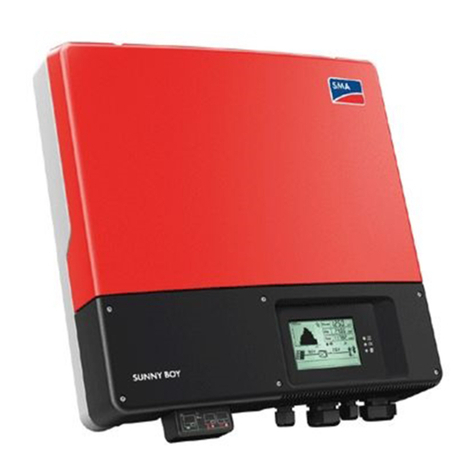Senlan SB200 Series User manual

I
SENLAN INVERTER
USER’S MANUAL
SB200 Series Inverter
High Performance General Space Verctor Control
Input: 3 Phase 400v class
Capacty:1.5 ~ 400kw
Version 1.3
Hope Senlan Science & Technology Holding Corp., Ltd.

II
Table of Contents
PREFACE ..........................................................................................................................................................1
1. NOTES ON SAFETY............................................................................................................................... 3
1.1. Notes on Safety................................................................................................................................................3
1.2. Caution:............................................................................................................................................................4
2. PRODUCT SPECIFICATION............................................................................................................. 8
2.1. Universal Technical Specification of SB200 Inverter Series .......................................................................... 8
2.2. Specification of the Inverter Series ...............................................................................................................10
3. INSTALLATION AND WIRING......................................................................................................14
3.1. Inverter Installation........................................................................................................................................14
3.2. Uninstallation/Installation of Inverter Components......................................................................................15
3.3 Wiring of Inverter ...........................................................................................................................................17
3.4. Electromagnetic Interference Control Methods ............................................................................................23
4. INVERTER OPERATION AND TRIAL OPERATION......................................................... 26
4.1. Inverter Operation and Display .....................................................................................................................26
4.2. Initial Energization ........................................................................................................................................31
4.3. Guide to Quick Debugging............................................................................................................................ 31
5. LISTS OF FUNCTION PARAMETERS....................................................................................... 33
F0: Basic Parameters ............................................................................................................................................33
F1: Acceleration/Deceleration, Startup, Shutdown and Jog Parameters..............................................................35
F2: V/F Control Parameters..................................................................................................................................37
F3. Motor Parameters ...........................................................................................................................................38
F4: Digital Input Terminals and Multi-Speed.......................................................................................................38
F5: Settings of Digital Output and Relay Output .................................................................................................40
F6: Terminals Settings for Analog Quantities and Pulse Frequency....................................................................43
F7: PID Parameters............................................................................................................................................... 47
F8: Dedicated Water Supply Functions ................................................................................................................48
F9: Time Management (Applicable to LCD Control Panel Only) .......................................................................53
Fb: Protection Functions and Advanced Inverter Settings ................................................................................... 54
FC: Keyboard Operation and Display Settings .................................................................................................... 58
FF: Communcation Parameters ............................................................................................................................ 59
Fn: Factory Settings..............................................................................................................................................60
FP: Fault Logs....................................................................................................................................................... 61
FU: Data Monitoring ............................................................................................................................................63
6. DETAILS ABOUT FUNCTION PARAMETERS .....................................................................65
6.1. F0: Basic Parameters .....................................................................................................................................65
6.2. F1: Acceleration/Deceleration, Startup, Shutdown and Jog Parameters.......................................................69
6.3. F2: V/F Control Parameters...........................................................................................................................74
6.4. F3: Motor Parameters ....................................................................................................................................79
6.5. F4: Digital Input Terminals and Multi-Speed ............................................................................................... 80
6.6. F5: Digital Output and Relay Output Settings ..............................................................................................90
6.7 F6: Settings of Analog Quantities and Pulse Frequency Terminals ...............................................................97

III
6.8 F7: PID Parameters.......................................................................................................................................105
6.9. F8: Dedicated Water Supply Functions ....................................................................................................... 111
6.10. F9: Time Management (Applicable to LCD Control Panel Only)............................................................123
6.11 Fb: Protection Functions and Advanced Inverter Settings ......................................................................... 126
6.12 FC: Keyboard Operation and Display Settings ..........................................................................................135
6.13 FF: Communication Parameters .................................................................................................................138
6.14 FP: Fault Lists............................................................................................................................................. 147
6.15 FU: Data Monitoring ..................................................................................................................................149
7 SOLUTIONS TO FAULTS AND ABNORMALITIES ...........................................................151
7.1 Inverter Faults and Solutions........................................................................................................................151
7.2 Inverter Alarms and Solutions ...................................................................................................................... 155
7.3. Inverter Operation Abnormalities and Solutions.........................................................................................157
8. UPKEEP, MAINTENANCE AND AFTER-SALES SERVICE.........................................159
8.1. Daily Upkeep and Maintenance ..................................................................................................................159
8.2. Regular Maintenance ...................................................................................................................................159
8.3. Replacement of Inverter Wearing Parts....................................................................................................... 160
8.4. Storage of Inverters...................................................................................................................................... 160
8.5. After-Sales Service ...................................................................................................................................... 161
9. OPTIONAL FITTINGS......................................................................................................................162
9.1 Braking Units................................................................................................................................................162
9.2 Communication Components .......................................................................................................................163
9.3 AC Reactor on the Input Side ....................................................................................................................... 163
9.4 EMI Filter and Ferrite Chip Common Mode Filter...................................................................................... 163
9.5. Digital I/O Extension Board........................................................................................................................ 163
9.6 Relay Extension Unit (SL-5X6T).................................................................................................................164
9.7 Control Panel Complete with Parameter Copying (SB-PU70E)..................................................................166
9.8 LCD Control Panel Complete with Parameter Copying (SB-PU 200; Simplified Chinese Version)..........166
9.9. Control Panel Mounting Box....................................................................................................................... 171
10. APPLICATION EXAMPLES ........................................................................................................172
10.1. Example 1: Two Variable-Frequency Cyclic Switchover Pumps (under Common Control) plus
One Auxiliary Pump ................................................................................................................................... 172
10.2. Example 2: Constant Pressure Water Supply by Inverter plus Soft Starter .............................................. 173
11 VERSION INFORMATION ............................................................................................................176


Preface
1
Preface
Thank you for selecting Senlan SB200 frequency inverter series. SB200 series integrate the optimized
high-performance space vector control VVVF algorithm which supports numerous advanced functions,
e.g. auto torque boost, slip compensation, oscillation suppression, tracking startup, stall prevention,
precise deadband compensation, auto voltage stabilization, process identification and auto carrier
frequency adjustment. With inbuilt constant pressure water supply and clock modules, the series are
suitable for most industrial control applications.
This manual provides the user with a guide on installation & wiring, parameter setting, daily
maintenance, fault diagnosis and troubleshooting. The user is required to peruse the whole content of
the manual carefully and be familiarized with the relevant know-how and notes on inverter safety
before any attempts of installation, setting, operation and maintenance.
The technical specifications applied to this product or the content of this manual may be subject to any
change without prior notifying.
This manual is required to be kept properly until the inverter is out of its service life.
Items to Be Checked on Opening the Packing Case
The user is required to carefully check and confirm the following items on opening the packing case. If
you have any problem, don’t hesitate to contact us or your supplier for a solution.
What to Confirm How to Confirm
Is the inverter identical with the
product you’ve ordered?
Check if the nameplate inscriptions on the side of the inverter
comply with the requirements in your order
If there is any damages on the
product?
Check the overall appearance of the product to see if there are
any damages arising from transportation
Inverter Model Description
SB200 -15 T 4
Slanvert Frequency
Inverter SB200 Series
Rated Capacity:15kW
400V Class
Three Phase

Preface
2
Inverter Nameplate Inscriptions (Instance: SB200-15T4)
Definition of Safety ID Markings
Any safety-specific content of this manual may use the following markings for identification. The user
is required to follow the instructions of the content identified with safety markings.
CAUTION: Any wrong operation or against the instructions may cause inverter damage or
personal injury/fatality.
CAUTION: Any noncompliant operation may cause abnormal system operation which, in
serious cases, may induce inverter damage or mechanical damage.
SENLAN INVERTER MADE IN CHINA
Model: SB200-15T4 Applicable Standard: GB/T12668.2
Rated Input: 3phase 380v 50/60Hz Product No.: 1234567
Rated Output: 3phase 0~380v 0~650Hz
Rated Current: 30A
RatedPower:15kw
SLANVERT Hope Senlan Science & Technology Holding Corp., ltd
Bar Code

Notes on Safety
3
1. Notes on Safety
1.1. Notes on Safety
(1) Installation
The inverter must not be installed at places with combustibles or in the vicinity of
combustibles; otherwise there may cause fire.
The inverter must not be installed in an environment exposed to flammable gases;
otherwise There may cause explosion.
(2) Wiring
Confirm that the HV indicator lamp is thoroughly extinguished and the positive/negative
busbar voltage is below 36V; otherwise there may be a risk of electric shock.
Confirm that no wiring operation is permitted unless the power supply is thoroughly
disconnected; otherwise there may be an electric shock hazard.
Don’t try to connect the DC terminals (P+/N-) directly with a dynamic braking resistor;
otherwise there may be a fire hazard.
The terminal voltage of the power supply must not exceed the rated voltage; otherwise
there may be inverter damage.
The earth terminal of the inverter must be properly and reliably earthed in compliance
with the applicable national technical specifications; otherwise there may be an electric
shock hazard;
(3) Inspection Prior to Connection to Power Supply
Prior to connection to the power supply, remember to check that proper wiring is provided
for the electrical peripherals, especially electrical circuits related to the safety of air circuit
breakers and fault alarm devices.
Prior to connection to the power supply, remember to close the cover of the inverter;
otherwise there may be an electrical shock or explosion.
The inverter provides control for high-speed operation of electric motors. If you intend to
apply the inverter to a frequency above the rated motor frequency, you must confirm that
the motor and the electrical parts can support high-speed operation.
(4) Notes on Connection to Power Supply and Operation
Prior to a trial operation, check that all parameters are correctly set.
The front cover must not be opened when the power supply is available, for the high
voltage within may cause an electrical shock.
Do not try to operate an inverter with wet hands; otherwise there may be an electrical
shock.

Notes on Safety
4
Factory settings for inverter self-start must be configured as “ALLOWED”. If terminal
control is available and operation signals are effective, the inverter will self-start upon
connection to the power supply.
Do not try to start up or shut down the inverter by direct disconnection from the power
supply.
Reconfigure the relevant parameters after the execution parameters are initialized.
After the restart function is selected (as in the event of a fault self-reset or a restart after
instantaneous power failure), do not approach the electric motor or mechanical load while
the inverter is ready for a startup.
(5) Notes on Transportation and Packaging
Do not pile more inverters than allowed by the packing cases.
Do not put weights on inverters.
Do not leave the cover open while the inverters are in transit.
Do not apply forces to the control panel or the cover while the inverters are being
handled; otherwise personal injuries or property damage may occur.
(6) Disposal on Expiration of Service Life
Dispose of the inverter as industrial waste.
Explosions may occur if the electrolytic capacitor within the inverter is being burnt.
Toxic gases may be emitted when the plastic parts of the inverter are burnt.
1.2. Caution:
(1) Ambient Conditions
An SB200 inverter must be used in an environment conforming to the product specification;
otherwise there may be a fault or shortened product life.
(2) Motor and Electrical Load
Comparison with Line Frequency Operation
The SB200 series are PWM voltage inverters with a certain level of harmonics in output voltage.
Compared with a line frequency power supply, the voltage loss, temperature rise and noise
generated by a working motor are slightly higher.
If the voltage of the power supply is relatively high or the wiring of the motor extends a long
distance, insulation strength of the cables and the motor must be taken into consideration.
Constant-Torque Low-Speed Operation
When a conventional motor driven by an inverter is in prolonged low-speed operation, the
motor temperature will rise because the heat dissipation effect of the motor becomes poorer. If

Notes on Safety
5
a prolonged constant-torque low-speed operation is required, a variable-frequency motor must
be selected, or forced air cooling be provided.
Motor Overload Protection
When an adapted motor is used, the inverter can provide overload protection for the motor. If
the motor does not match the rated inverter capacity, adjust the parameters for protection, or
take any other protection measure to ensure safe motor operation.
Operation at a Frequency above the Rated Motor Frequency
If the motor runs at a frequency above the rated frequency, the user must confirm that the speed
range of the motor bearing and mechanical parts supports the operation, in addition to motor
vibration and noise increase.
Lubrication of Mechanical Devices
Mechanical devices requiring lubrication, such as the gearbox and gears, may be damaged by
deteriorating lubrication caused by prolonged low-speed operation. Confirm that prior to
lubrication.
Regenerated Torque Load
On such occasions as load elevation, there are frequent cases of regenerative torque, which may
cause inverter shutdowns for overvoltage protection. Therefore, the user must consider selecting
specific braking units of a proper specification.
Mechanical Resonance Points of Load-Carrying Devices
Load-carrying devices may have mechanical resonance points that respond to the inverter in a
specified output frequency range. The resonance effect may be dampened by installing
vibration-resistant rubber pads under the base plate of the motor or avoided by configuring the
avoidance frequency of the inverter.
Motor Insulation Check Prior to Connection to the Inverter
The motor must be checked for insulation before a commissioning or operation after a longtime
shutdown to prevent an inverter damage caused by deteriorated winding insulation. The
insulation test must be aided with a 500V voltage-type megger. The measured insulation
resistance must be at least 5MΩ. Do not use motors with poor insulation ratings. As the inverter
provides power supply to the motor in a PWM mode, a poor insulation rating motor is
susceptible to insulation damage.
(3) Inverter
Capacitors or Pressure-Sensitive Elements to Improve Power Factor
As the output voltage of the inverter is PWM voltage, any installation of power
factor-improving capacitors or lightning protection pressure-sensitive resistors at the output
terminal may induce inverter trip or element damage. Uninstall any such capacitor or resistor.

Notes on Safety
6
Contactor, etc. Installed at the Output Terminal of the Inverter
If installation of contactors, etc. is required between the output terminal and the motor, please
ensure that make-break operations are conducted when the inverter has no power output;
otherwise the inverter may be damaged.
Frequent Startup/Shutdown Operations
Control terminals are recommended for the startup/shutdown of the inverter. The user is
absolutely not permitted to directly shut down or start up the inverter via such circuit-breakers
as a contactor on the input terminal of the inverter.
Application beyond the Rated Voltage
It is inadvisable to apply the SB200 inverter series to ranges beyond the permitted input
voltage. If the user needs to apply the inverter to ranges beyond the rated voltage, please use a
step-up or step-down transformer for transformation.
Switching from 3-Phase Input to Single Phase Input
The change from 3-phase input to single phase input will augment the voltage/current ripples
of the busbar. Ripples affect the service life of capacitors in the main circuit and deteriorate
the performance of the inverter as well.
It is not recommended to switch to single-phase input. If a single-phase power supply is necessitated,
the user must cancel phase-failure protection and reduce the ratings to a max of 60%. If a 30kW
inverter or above requires to be changed to single phase input, ensure that the single-phase input
terminal is connected to Terminals R and S, otherwise the inverter will fail to work.
Lightning Surge Protection
The inverter has an inbuilt lightning overvoltage protector capable of self-protection against
induced lightning shocks.
Leakage Protector
Quick startups or shutdowns during inverter operation necessarily induce high-frequency
leakage currents, which may sometimes cause misoperations of the leakage protection circuit.
In the event of the aforesaid problems, reduce the carrier frequency and the length of the
lead-in wire appropriately; besides, the leakage protector must be correctly installed.
Keep the following points in mind when installing a leakage protector:
1) It is more proper to install the protector at the input terminal of the inverter and behind the air
circuit-breaker (not a fuse circuit-breaker).
2) The selected leakage protector must be insensitive to higher harmonics (sensitivity: Above
30mA) or specially suited for inverter applications. If a common leakage protector is selected, it
must have sensitivity above 200mA and an action time above 0.1s.
Inverter Derating
1) When the ambient temperature exceeds 40℃, the inverter must be derated by 5% for every

Notes on Safety
7
increment of one degree Celsius. Also, forced external heat dissipation must be provided.
2) At 1,000m above sea level, the thinner air will deteriorate the heat dissipation effect of the
inverter. Therefore, the inverter must be derated by 1% for every increment of 100m.
3) When the set carrier frequency exceeds the factory settings, the inverter must be derated by 5%
for every increment of 1kHz.

Product Specification
8
2. Product Specification
2.1. Universal Technical Specification of SB200 Inverter Series
Item Description
Rated Voltage/Frequency 3-phase, 380V; 50/60Hz
Input
Range Voltage: 320-420V; voltage unbalance:<3 %;
frequency: 47-63Hz
Output Voltage 3-phase; 0v-input voltage; error: below 5%
Output Frequency 0.00-650.00Hz
Overload Capacity 110% of rated current; 1 minute
Frequency Resolution Digital setting: 0.01Hz; analog setting: 0.1% of max
frequency
Output Frequency Accuracy Analog setting: ±0.2%of max frequency (25±10℃);
digital setting: 0.01Hz (-10—+40℃)
Command Execution Channel
Settings may be configured via the control panel,
control terminal or communication port. Switching is
enabled via the terminal
Frequency Setting Channel Control panel, communication port, UP/DOWN
adjustment, AI1, AI2, AI3 or PFI
Auxiliary Frequency Setting Flexible auxiliary frequency micro-adjustment and
frequency setting synthesis
Torque Elevation Auto/manual torque elevation
V/F Curve Customizable V/F curves, linear V/F curves and 5
torque reduction characteristic curves
Jogging Jogging frequency range: 0.10-50.00Hz; jogging
acceleration/deceleration time: 0.1-60.0s
Auto Energy Saving Load-based auto V/F optimization, capable of auto
energy saving
AV R
When the grid voltage fluctuates within a specified
range, the inverter can automatically maintain a
constant output voltage
Auto Carrier Regulation Auto carrier regulation based on load characteristics
and ambient temperature
Random PWM Tone adjustment for an operating motor
Instantaneous Power Failure
Solution
Uninterrupted operation via busbar voltage regulation
in the event of an instantaneous power failure
DC Braking Braking time: 0.0-60.0s; braking current: 0.0-100.0%
of rated current
PFI Max input frequency: 50kHz
PFO Connector open circuit-type pulse square wave signal
output; programmable
Analog Input
3-channel analog signal input; options for
voltage/current modes; capable of positive/negative
input
Analog Output 2-channel analog signal output; options for 0/4-20mA
or 0/2-10V; programmable
Digital Input 8-channel multifunctional digital input
Digital Output 2-channel multifunctional collector open-circuit
output; 5-channel multifunctional relay output
Output
Communication Inbuilt RS48S communication interface supporting
Modbus protocol and USS commands
Feature Process Identification Two PID parameter systems and multiple correction
modes

Product Specification
9
Item Description
Water Supply Mode
Multiple water supply modes: fire water control,
water injection control, clean water pool inspection,
wastewater pool inspection, drainage pump control,
sleeping, pump change at regular intervals and pump
overhaul
Custom Menu 30 user parameters can be customized
Change of Parameter Display Parameter display different from the factroy settings
is supported
KWH Meter Convenient for adjustment of the optimized energy
saving schemes
Protection
Protection is available for overcurrent, overvoltage,
undervoltage, input/output phase lack, output
short-circuit, overheat, motor overload, external fault,
analog input disconnection, stall prevention, etc.
Fittings
Braking units, extension cords for control panel,
remote control box, digital I/O extension boards, relay
extension boards, control panel capable of parameter
copying (SB-PU70E) and LCD- display control panel
(SB-PU200)
Application
Indoors; an elevation below 1,000m; away from
exposure to direct sunlight, dust, corrosive gases,
combustible gases, oil mist, water vapor, drippings
and saline mist
Ambient Temperat-
ure/Humidity
-10-+40℃/<90%RH; no condensate or dew
StorageTemperature -20-+60℃
Environment
Vibration Below 5.9m/s2(0.6g)
IP Rating IP20
Structure Cooling Mode Force air cooling with fan control

Product Specification
10
2.2. Specification of the Inverter Series
Refer to the following table for the ratings of the SB200 inverter series:
Common Application
(110%IN every 10 minutes on
every minute)
Heavy Load Application
(150%Ihd every 10 minutes on
every minute)
Model No.
Rated
Capacity
(kVA) Rated Output
Current (A)
Adapted
Motor
(kW)
Rated Output
Current (A)
Adapted
Motor
(kW)
SB200-1.5T4 2.4 3.7 1.5 3 1.1
SB200-2.2T4 3.6 5.5 2.2 3.7 1.5
SB200-4T4 6.4 9.7 4 5.5 2.2
SB200-5.5T4 8.5 13 5.5 9.7 4
SB200-7.5T4 12 18 7.5 13 5.5
SB200-11T4 16 24 11 18 7.5
SB200-15T4 20 30 15 24 11
SB200-18.5T4 25 38 18.5 30 15
SB200-22T4 30 45 22 38 18.5
SB200-30T4 40 60 30 45 22
SB200-37T4 49 75 37 60 30
SB200-45T4 60 91 45 75 37
SB200-55T4 74 112 55 91 45
SB200-75T4 99 150 75 112 55
SB200-90T4 116 176 90 150 75
SB200-110T4 138 210 110 176 90
SB200-132T4 167 253 132 210 110
SB200-160T4 200 304 160 253 132
SB200-200T4 248 377 200 304 160
SB200-220T4 273 415 220 377 200
SB200-250T4 310 475 250 415 220
SB200-280T4 342 520 280 475 250
SB200-315T4 389 590 315 520 280
SB200-375T4 460 705 375 590 315
SB200-400T4 490 760 400 705 375

Product Specification
11
数字给定频率
37.00Hz
普通运行给定
返回
?
编辑
SB200
W
A
L
B
d
L1
H
An Outline Drawing of the Inverter Series (SB200-1.5T4—5.5T4) (Installable with a standard DIN
Guide Rail)
W
B
L
d
H
A
SB200
An Outline Drawing of the Inverter Series (SB200-7.5T4—22T4)

Product Specification
12
W
A
d
B
L
H
L1
SB200
An Outline Drawing of the Inverter Series (SB200-30T4 and above)

Product Specification
13
Refer to the following table for the overall dimension and weight of the SB200 inverter series:
Model No. W
(mm)
L
(mm)
L1
(mm)
H
(mm)
A
(mm)
B
(mm)
D
(mm)
Weight
(kg)
SB200-1.5T4
SB200-2.2T4
100 180 105 157 87.5 170 Φ4.5 2
SB200-4T4
SB200-5.5T4
135 240 140 170 125 230 Φ4.5 3
SB200-7.5T4
SB200-11T4 150 300 -195 138 288 Φ5.5 7
SB200-15T4
SB200-18.5T4
SB200-22T4
200 380 -225 185 367 Φ7 10
SB200-30T4
SB200-37T4 275 470 440 256 200 455 Φ8
SB200-45T4
SB200-55T4 280 570 520 290 200 550 Φ10
SB200-75T4
SB200-90T4 310 680 630 330 220 660 Φ10
SB200-110T4
SB200-132T4 350 800 750 330 220 780 Φ12
SB200-160T4
SB200-200T4 410 940 884 318 300 920 Φ12
SB200-220T4
SB200-250T4
SB200-280T4
500 1060 1000 355 320 1038 Φ12
SB200-315T4 650 1180 1110 360 540 1152 Φ13
SB200-375T4
SB200-400T4 650 1250 1180 360 540 1222 Φ13

Installation and Wiring
14
3. Installation and Wiring
3.1. Inverter Installation
CAUTION
1. The installation of the inverter may only be carried out by trained
professionals.
2. Do not try to install a inverter if it is damaged or incomplete with any part;
otherwise there may be hazards of fire or personal injuries.
3. Install the inverter where there is sufficient support for the inverter weight;
otherwise there may be hazards of personal injuries or property damage in
the event of a fall.
4. Do not apply forces to the control panel or the cover when handling the
inverter; otherwise there may be hazards of personal injuries or property
damage.
The inverter must be installed in a room with sound ventilation. Keep the following points in mind
when choosing a place of installation:
(1) The ambient temperature must be controlled between -10℃and 40℃. As theinverter life is affected
by the ambient temperature to a great extent, the user must ensure that the ambient temperature is
within the tolerable range. When the temperature exceeds 40℃, the inverter must be derated by 5%
for every increment of 1 degree Celsius. Besides, forced external heat dissipation must be provided.
(2) At 1,000m above sea level, the thinner air will deteriorate the heat dissipation effect of the inverter.
Therefore, it is necessary to derate the inverter by 1% for every increment of 100m.
(3) The humidity must be lower than 90%RH and there must not be condensates or dews.
(4) The inverter must be installed at a place where the vibration is less than 5.9m/s2(0.6g).
(5) The inverter must be installed at a place away from exposure to direct sunlight.
(6) The inverter must not be installed at a very dusty place or a place fraught with metal dust.
(7) The user must not install the inverter at a place exposed to corrosive or combustible gases.
(8) The inverter must be installed in a vertical way. Do not install it in an upside-down, slanted or
horizontal way. Use proper screws to fix it onto a firm structure. Please refer to the following
drawings for the requirements on the spacing and distance (if two inverters are installed in a
vertically aligned way, a baffle plate must be installed in between to keep them apart).

InstallationandWiring
15
3.2. Uninstallation/Installation of Inverter Components
3.2.1. Uninstallation/Installation of Cover and Control Panel
3.2.2. Uninstallation/Installation of Control Panel
Uninstallation: Stick a finger into the hemispheric depression above the control panel, press the
elastic flap on top of the panel and pull the panel out. Refer to the following drawing.
Installation: Fit the fixing bayonet at the bottom of the panel into the dog at the bottom of the
installation slot of the panel, press the upper side forward with a finger and release the finger
after the panel is in place. Refer to the following drawings:

Installation and Wiring
16
3.2.3. Installation of Control Panel on Cabinet Panel
The user may remove the control panel from the SB200 inverter series and install it on the
cabinet panel. The control panel and the inverter may be connected by an extension cord. The
user may choose from the following two installation methods:
Method 1: Direct Installation:
①Drill holes and openings on the cabinet panel as per the following drawing:
②Remove the control panel and then the two screws on the diagonal line of the panel. Then fix
the panel onto the cabinet panel with the complimentary M3×14 screws.
③Insert the socket at one end of the extension cord into the control panel and fix it with the
complimentary fasteners. The other end of the cord should be plugged firmly into the
corresponding socket on the circuit board of the inverter. Take care to cover the inverter.
Method 2: Installation into the Mounting box:
①Make an opening in the cabinet panel as per the following drawing.
②Install the mounting box (optional) of the control panel onto the cabinet panel.
③Install the control panel into the box.
2× 4
4
Hole drilling for installing the
control panel onto the cabinet
Rectangular hole
for the cord
The thickness of
the cabinet panel
is less than 3mm
Screw Hole
Two M33×14
screws are needed
The complimentary T/SL-23
fastener is used to prevent the
plug of the extension cord from
coming off the control panel
This manual suits for next models
21
Table of contents
Other Senlan Inverter manuals
Popular Inverter manuals by other brands
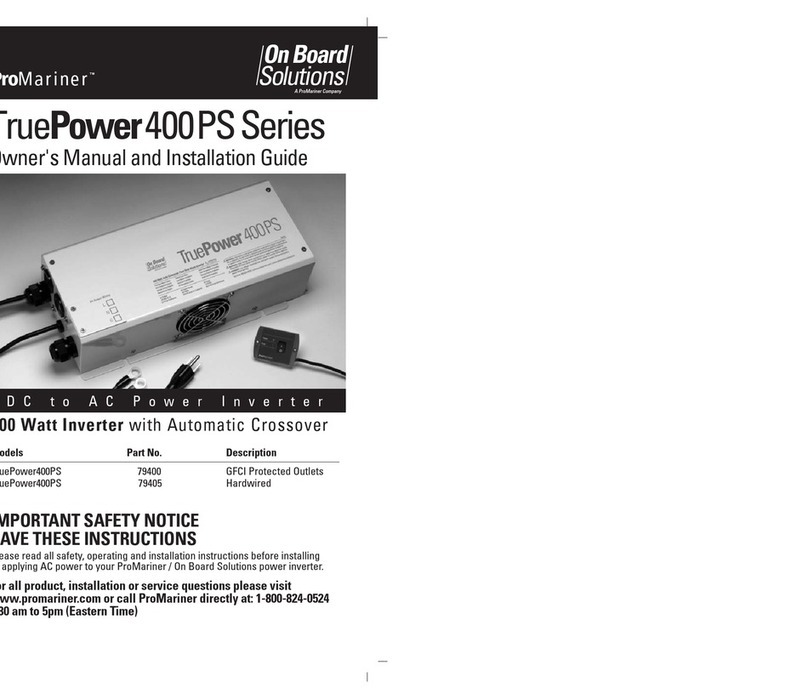
ProMariner
ProMariner True Power 400PS Series Owner's manual and installation guide

Beretta
Beretta IDRA DS 200 Installation and operation manual and parts

Delta
Delta RPI M6A Quick installation guide
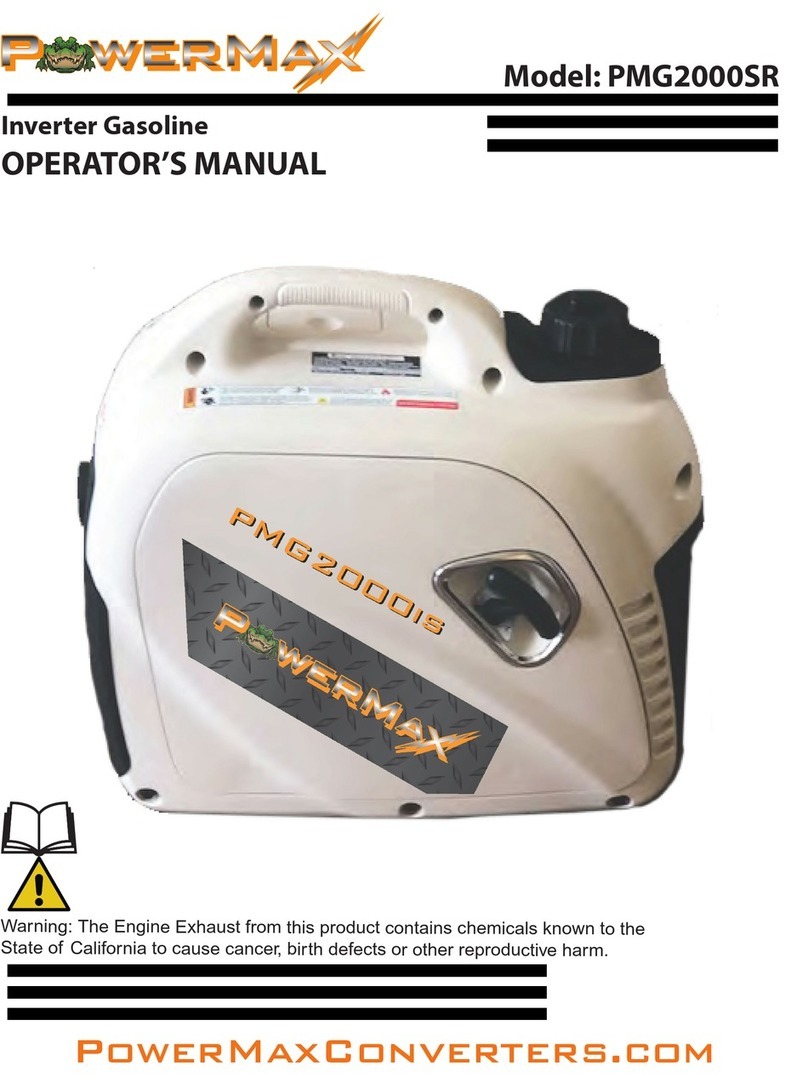
Power Max
Power Max PMG-2000iS Operator's manual
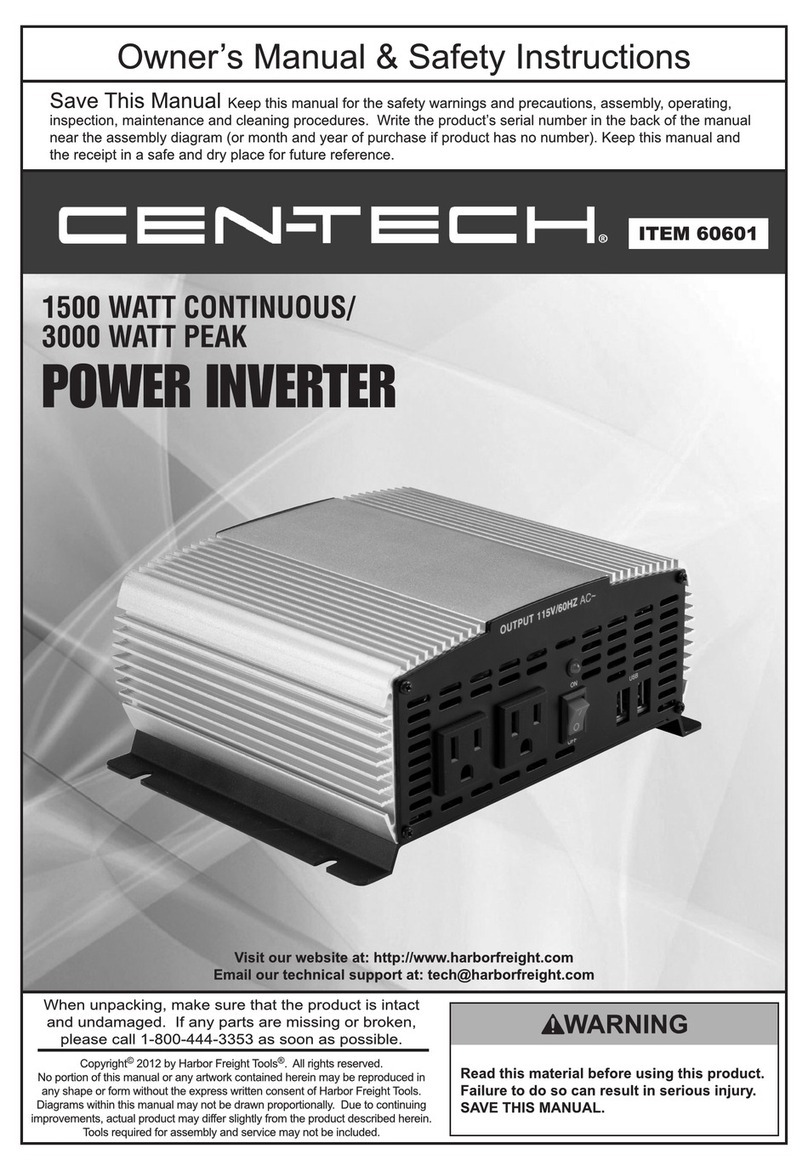
Centech
Centech 60601 Owner's manual & safety instructions
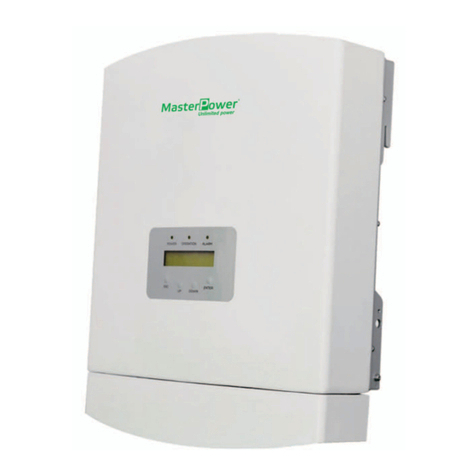
MasterPower
MasterPower RAI-3K-48ES-5G instruction manual
